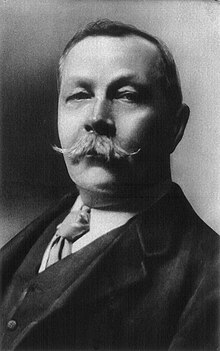About the Book: "The Adventure of the Dancing Men", one of the 56 Sherlock Holmes short stories written by British author Sir Arthur Conan Doyle, is one of 13 stories in the cycle collected as The Return of Sherlock Holmes. Doyle ranked "The Adventure of the Dancing Men" third in his list of his twelve favorite Holmes stories. This is one of only two Sherlock Holmes short stories where Holmes' client dies after seeking his help. The other is "The Five Orange Pips", part of The Adventures of Sherlock Holmes.
About the Author: Arthur Ignatius Conan Doyle was born on 22 May 1859 at 11 Picardy Place, Edinburgh, Scotland. From 1876 to 1881, he studied medicine at the University of Edinburgh, including a period working in the town of Aston (now a district of Birmingham) and in Sheffield, as well as in Shropshire at Ruyton-XI-Towns. While studying, Doyle began writing short stories. His earliest extant fiction, "The Haunted Grange of Goresthorpe", was unsuccessfully submitted to Blackwood's Magazine. His first published piece "The Mystery of Sasassa Valley", a story set in South Africa, was printed in Chambers's Edinburgh Journal on 6 September 1879. On 20 September 1879, he published his first non-fiction article, "Gelsemium as a Poison" in the British Medical Journal. In 1882 he joined former classmate George Turnavine Budd as his partner at a medical practice in Plymouth, but their relationship proved difficult, and Doyle soon left to set up an independent practice. Arriving in Portsmouth in June of that year with less than £10 (£900 today) to his name, he set up a medical practice at 1 Bush Villas in Elm Grove, Southsea. The practice was initially not very successful. While waiting for patients, Doyle again began writing stories and composed his first novels, The Mystery of Cloomber, not published until 1888, and the unfinished Narrative of John Smith, which would go unpublished until 2011. He amassed a portfolio of short stories including "The Captain of the Pole-Star" and "J. Habakuk Jephson's Statement", both inspired by Doyle's time at sea, the latter of which popularized the mystery of the Mary Celeste and added fictional details such as the perfect condition of the ship (which had actually taken on water by the time it was discovered) and its boats remaining on board (the one boat was in fact missing) that have come to dominate popular accounts of the incident. Doyle struggled to find a publisher for his work. His first significant piece, A Study in Scarlet, was taken by Ward Lock Co. on 20 November 1886, giving Doyle £25 for all rights to the story. The piece appeared later that year in the Beeton's Christmas Annual and received good reviews in The Scotsman and the Glasgow Herald. The story featured the first appearance of Watson and Sherlock Holmes, partially modeled after his former university teacher Joseph Bell. Doyle wrote to him, "It is most certainly to you that I owe Sherlock Holmes ... Round the center of deduction and inference and observation which I have heard you inculcate I have tried to build up a man." Robert Louis Stevenson was able, even in faraway Samoa, to recognize the strong similarity between Joseph Bell and Sherlock Holmes: "My compliments on your very ingenious and very interesting adventures of Sherlock Holmes. ... Can this be my old friend Joe Bell?" Other authors sometimes suggest additional influences—for instance, the famous Edgar Allan Poe character C. Auguste Dupin. A sequel to A Study in Scarlet was commissioned and The Sign of the Four appeared in Lippincott's Magazine in February 1890, under agreement with the Ward Lock company. Doyle felt grievously exploited by Ward Lock as an author new to the publishing world and he left them. Short stories featuring Sherlock Holmes were published in the Strand Magazine. Doyle first began to write for the 'Strand' from his home at 2 Upper Wimpole Street, now marked by a memorial plaque. In this period, however, Holmes was not his sole subject and in 1893, he collaborated with J.M. Barrie on the libretto of Jane Annie. Doyle was found clutching his chest in the hall of Windlesham Manor, his house in Crowborough, East Sussex, on 7 July 1930. He died of a heart attack at the age of 71. His last words were directed toward his wife: "You are wonderful." At the time of his death, there was some controversy concerning his burial place, as he was avowedly not a Christian, considering himself a Spiritualist. He was first buried on 11 July 1930 in Windlesham rose garden. He was later reinterred together with his wife in Minstead churchyard in the New Forest, Hampshire. Carved wooden tablets to his memory and to the memory of his wife are held privately and are inaccessible to the public. That inscription reads, "Blade straight / Steel true / Arthur Conan Doyle / Born May 22nd 1859 / Passed On 7th July 1930." The epitaph on his gravestone in the churchyard reads, in part: "Steel true/Blade straight/Arthur Conan Doyle/Knight/Patriot, Physician, and man of letters". Undershaw, the home near Hindhead, Haslemere, south of London, that Doyle had built and lived in between October 1897 and September 1907, was a hotel and restaurant from 1924 until 2004. It was then bought by a developer and stood empty while conservationists and Doyle fans fought to preserve it. In 2012 the High Court ruled that the redevelopment permission be quashed because proper procedure had not been followed. A statue honours Doyle at Crowborough Cross in Crowborough, where he lived for 23 years. There is also a statue of Sherlock Holmes in Picardy Place, Edinburgh, close to the house where Doyle was born.
My Review: In this story, Mr. Hilton Cubitt of Ridling Thorpe Manor in Derbyshire visits Sherlock Holmes and gives him a piece of paper with a mysterious sequence of stick figures representing dancing men.
The little dancing men are at the heart of a mystery which seems to be driving his young wife Elsie Patrick to distraction. He married her about 3 years ago, and until recently, everything was well. She is American, and before the wedding, she asked her husband-to-be to promise her never to ask about her past, as she had had some “very disagreeable associations” in her life, although she said that there was nothing that she was personally ashamed of. Mr. Cubitt swore the promise and, being an honorable English gentleman, insists on living by it, which is one of the things causing difficulty at Ridling Thorpe Manor.
The trouble began when Elsie received a letter from the United States, which evidently disturbed her, and she threw the letter on the fire. Then the dancing men appeared, sometimes on a piece of paper left on the sundial overnight, sometimes scrawled in chalk on a wall or door, even a windowsill. Each time, their appearance has an obvious, terrifying effect on Elsie, but she will not tell her husband what is going on. Holmes tells Cubitt that he wants to see every occurrence of the dancing men. They are to be copied down and brought or sent to him at 221B Baker Street. Cubitt duly does this, and it provides Holmes with an important clue. Holmes comes to realize that it is a substitution cipher. He cracks the code by frequency analysis. The last of the messages conveyed by the dancing men is a particularly alarming one.
Holmes rushes down to Ridling Thorpe Manor only to find Cubitt dead of a bullet to the heart and his wife gravely wounded in the head. Inspector Martin of the Norfolk Constabulary believes that it is a murder-suicide, or will be if Elsie dies. She is the prime suspect in her husband’s death. Holmes sees things differently. Why is there a bullet hole in the windowsill, making a total of three shots, while Cubitt and his wife were each only shot once? Why are only two chambers in Cubitt’s revolver empty? What is the large sum of money doing in the room? The discovery of a trampled flowerbed just outside the window and the discovery of a shell casing therein confirm what Holmes has suspected: a third person was involved, and it is surely the one who has been sending the curious dancing-man messages.
Holmes knows certain things that Inspector Martin does not. He seemingly picks the name “Elrige’s” out of the air, and Cubitt’s stable boy recognizes it as a local farmer’s name. Holmes quickly writes a message — in dancing men characters — and sends the boy to Elrige’s Farm to deliver it to a lodger there, whose name he has also apparently picked out of the air. Of course, Holmes has learned both men's names by reading the dancing men code. While waiting for the result of this message, Holmes takes the opportunity to explain to Watson and Inspector Martin how he cracked the code of the dancing men, and the messages are revealed. The last one, which caused Holmes and Watson to rush to Norfolk, read “ELSIE PREPARE TO MEET THY GOD”.
The lodger, Mr. Abe Slaney, another American, unaware that Elsie is at death’s door and quite unable to communicate, duly arrives at Ridling Thorpe Manor a short while later, much to everyone’s astonishment, except Holmes’s. He has sent for Slaney using the dancing men, knowing that Slaney will believe that the message is from Elsie. He is seized as he comes through the door. He tells the whole story. He is Elsie's former fiancé from Chicago and has come to England to woo her back. She had originally fled his clutches because he was a dangerous criminal, as Holmes has found out through telegraphic inquiries to the US. When an encounter at the window where the killing happened turned violent with Hilton Cubitt's appearance in the room, Slaney pulled out his gun and shot back at Cubitt, who had already shot at him. Cubitt was killed and Slaney fled. Apparently, Elsie then shot herself. Slaney seems genuinely upset that Elsie has come to harm. The threatening nature of some of his dancing-man messages is explained by Slaney's losing his temper at Elsie's apparent unwillingness to leave her husband. The money found in the room was apparently to have been a bribe to make Slaney go away.
Slaney is arrested and later tried. He escapes the noose owing to mitigating circumstances. Elsie recovers from her serious injuries and spends her life helping the poor and administering her late husband’s estate.
Another masterpiece from Sir Conan Doyle. I recommend this book to the library of any reader who enjoys well written mystery stories, mainly featuring Sherlock Holmes.
If you read this review, feel free to leave a comment.



No comments:
Post a Comment